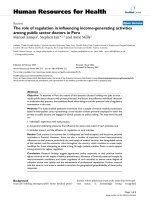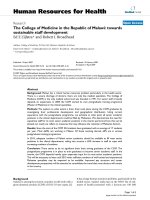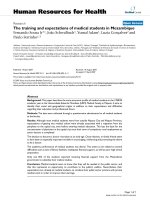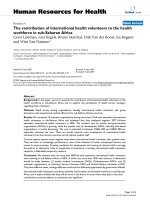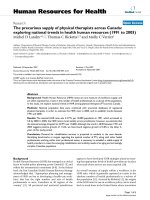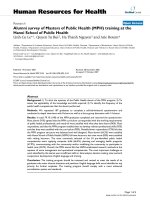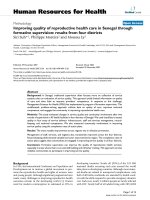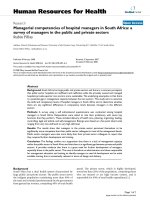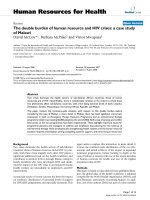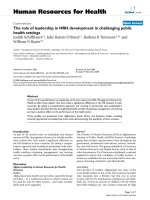Báo cáo sinh học: " The state of the art of adeno-associated virus-based vectors in gene therapy" ppt
Bạn đang xem bản rút gọn của tài liệu. Xem và tải ngay bản đầy đủ của tài liệu tại đây (318.85 KB, 7 trang )
BioMed Central
Page 1 of 7
(page number not for citation purposes)
Virology Journal
Open Access
Review
The state of the art of adeno-associated virus-based vectors in gene
therapy
Renata dos Santos Coura and Nance Beyer Nardi*
Address: Department of Genetics, Universidade Federal do Rio Grande do Sul, Av Bento Goncalves 9500, 91501-970, Porto Alegre, RS, Brazil
Email: Renata dos Santos Coura - ; Nance Beyer Nardi* -
* Corresponding author
Abstract
The adeno-associated virus (AAV) has rapidly gained popularity in gene therapy since the
establishment of the first AAV2 infectious clone, in 1982, due to some of their distinguishing
characteristics such as lack of pathogenicity, wide range of infectivity, and ability to establish long-
term transgene expression. Notably over the past decade, this virus has attracted considerable
interest as a gene therapy vector, and about 85% of the currently available 2,041 PubMed
references on adeno-associated viruses have been published during this time. The exponential
progress of AAV-based vectors has been made possible by the advances in the knowledge of the
virology and biology of this virus, which allows great improvement in AAV vectors construction
and a better comprehension of their operation. Moreover, with the recent discovery of novel AAV
serotypes, there is virtually one preferred serotype for nearly every organ or tissue to target. Thus,
AAV-based vectors have been successfully overcoming the main gene therapy challenges such as
transgene maintenance, safety and host immune response, and meeting the desirable vector system
features of high level of safety combined with clinical efficacy and versatility in terms of potential
applications. Consequently, AAV is increasingly becoming the vector of choice for a wide range of
gene therapy approaches. This report will highlight the state of the art of AAV-based vectors
studies and the advances on the use of AAV vectors for several gene therapy approaches.
Background
The adeno-associated virus (AAV) is a small, icosaedral
and nonenveloped virus that belongs to the parvovirus
family, specifically the Dependovirus genus. The mem-
bers of this genus require a helper virus, such as adenovi-
rus or herpes simplex virus, to facilitate productive
infection and replication. In the absence of a helper virus,
AAVs establish a latent infection within the cell, either by
site-specific integration into the host genome or by per-
sisting in episomal forms. The wild AAV capsid has
approximately 22 nm and encapsidates a linear single-
stranded DNA genome of about 4.7 kb of either plus or
minus polarity [1,2]. The AAV2 DNA termini consists of a
145 nucleotide-long inverted terminal repeat (ITR) that
forms a characteristic T-shaped hairpin structure, due to
the multipalindromic nature of its terminal 125 bases,
which allows its fold on itself via complementary base
pairing [3], forming a secondary structure that provides a
free 3' hydroxyl group for the initiation of viral DNA rep-
lication [4]. This viral replication process relies on host
cell polymerase activities, since AAV does not encode its
own polymerase [5]. These ITRs are the only cis-acting ele-
ments required for genome replication and packaging,
and flank the two large open reading frames (ORFs) of the
Published: 16 October 2007
Virology Journal 2007, 4:99 doi:10.1186/1743-422X-4-99
Received: 29 August 2007
Accepted: 16 October 2007
This article is available from: />© 2007 Coura and Nardi; licensee BioMed Central Ltd.
This is an Open Access article distributed under the terms of the Creative Commons Attribution License ( />),
which permits unrestricted use, distribution, and reproduction in any medium, provided the original work is properly cited.
Virology Journal 2007, 4:99 />Page 2 of 7
(page number not for citation purposes)
virus genome. The left ORF, Rep (replication), encodes
four replication proteins (Rep 78, Rep 68, Rep 52, and Rep
48), through the use of two different promoters and alter-
native splicing, responsible for site-specific integration,
nicking, and helicase activity, as well as regulation of pro-
moters within the AAV genome. The right ORF, Cap (cap-
sid), encodes, through alternative mRNA splicing and
alternative start codon usage, the three viral structural pro-
teins (VP1, VP2 and VP3) that assemble at a ratio of
approximately 1:1:10, respectively, to form a mature AAV
particle [6].
Following the establishment of the first infectious clone of
AAV serotype 2 (AAV2) in 1982 [7] and the pioneering
work on the successful cloning of AAV establishing the
foundation of recombinant AAV vectors capable of
expressing foreign genes in mammalian cells [8,9], in the
early 1980s, AAV2 vectors have rapidly gained popularity
in gene therapy applications, due to some of their distin-
guishing biological features. The unique life cycle of AAV
demonstrates how this class of viruses has adapted to
coexist with mammalian hosts in a manner that allows for
long-term persistence without any detectable deleterious
effect on the host. Despite the deceptively simple structure
of AAV, this virus is able to use its nonstructural proteins
to facilitate replication as a satellite of other DNA viruses
during its productive phase, as well as to establish stable
integrated and episomal forms during its latent phase
[4,10,11]. This requires numerous complex interactions
between AAV genomic elements, AAV proteins, host pro-
teins, and helper virus proteins [12]. Many of those mech-
anisms have been elucidated in detail for the AAV2, the
best characterized AAV serotype [13,14]. Therefore, the
nonpathogenic and persistent long-term nature of AAV
infection combined with its wide range of infectivity have
made this virus an important candidate as a therapeutic
gene transfer vector.
Recombinant adeno-associated viral (rAAV) vectors have
rapidly advanced to the forefront of gene therapy in the
past decade. The exponential progress of AAV-based vec-
tors has been made possible by the advances in the knowl-
edge of the virology and biology of this virus, which
allows great improvement in AAV vectors construction
and a better comprehension of AAV vectors operation.
Moreover, with the recent discovery of novel AAV sero-
types, there is virtually now one preferred serotype for
nearly every organ or tissue to target, since these isolates
are ideally suited to development into human gene ther-
apy vectors due to their diverse tissue tropisms and poten-
tial to evade preexisting neutralizing antibodies against
the common human AAV serotype 2. Thus, rAAV-based
vectors have been successfully overcoming the main gene
therapy challenges and meeting the desirable vector sys-
tem features of high level of safety combined with clinical
efficacy and versatility in terms of potential applications.
Consequently, rAAV are increasingly becoming the vector
of choice for a wide range of gene therapy approaches.
This review will originally highlight the state of the art of
AAV-based vector studies and the advances in the use of
AAV vectors in several gene therapy approaches.
Characteristics of AAV-based vectors
As mentioned above, in the early 1980s, pioneering work
on the successful cloning of AAV established the founda-
tion of recombinant AAV vectors capable of expressing
foreign genes in mammalian cells. Since then, the AAV has
been more and more studied and considered for gene
therapy applications. In all, 85% of the available (up to
June 2007) 2,041 PubMed references on AAV were pub-
lished during the last 10 years.
This increasing interest on AAV is justified by its character-
istic features that distinguish it from many other viral vec-
tor systems, such as retro/lentiviral and adenoviral
vectors, and turn it into a very attractive tool for gene ther-
apy. These features, as mentioned above, include: (1) its
nonpathogenicity and nonimmunogenicity as well as its
heat stability and resistance to solvents and to changes in
pH and temperature [15]; (2) AAV vectors only retain
about 300 nucleotides of viral sequence in the form of
nontranscribed ITRs, which greatly improves its safety for
human clinical applications by reducing the risk of recom-
bination with wild-type virus. Moreover, lack of viral cod-
ing sequences extends the duration of gene expression as
no viral gene products are expressed in target cells, which
reduces the risk of eliciting a cellular immune response;
(3) AAV vectors have a broad host and cell type tropism
range and transduce both dividing and nondividing cells
in vitro and in vivo. Furthermore, the recent discovery of
novel AAV serotypes will expand even more the universe
of potential target organs, tissues and cells; and (4) AAV
vectors maintain (over several years) high levels of gene
expression in vivo, in the absence of a significant immune
response to the transgene product. This is a major require-
ment for gene therapy approaches for some diseases, and
constitutes the most promising and distinguishing fea-
tures of AAV vectors.
However, there are also a few drawbacks in using AAV vec-
tors for gene therapy applications. (1) Their size limits the
insertion of gene expression cassettes. Whereas strategies
have been developed to overcome this limitation, those
approaches still suffer from low efficiency resulting in
decreased levels of gene expression. (2) Gene expression is
generally of slow onset, due to the requirement of conver-
sion of the single-stranded AAV DNA into double-
stranded DNA before gene expression can be initiated.
Strategies developed to overcome this limitation include
Virology Journal 2007, 4:99 />Page 3 of 7
(page number not for citation purposes)
the construction of double-stranded DNA vectors, but this
results in further reduction in the size capacity of trans-
gene insertion, as one has to incorporate the gene twice
into the vector (in its sense and antisense orientation). (3)
A possible association between AAV2 vector gene transfer
and tumorigenesis has been suggested, in a preclinical
study with an animal model for mucopolysaccharidosis
VII (MPS VII) [16]. To date, these results have not yet been
reproduced and the cause for the malignancies is still
unclear. And (4), some investigators have shown prefer-
ential integration of recombinant AAV2 vectors into tran-
scriptionally active chromatin regions [17,18].
Nevertheless, the overall frequency of rAAV2 integration is
very low and it is not clear yet whether this is a general
phenomenon or specific for liver or the model used or
AAV2.
The state of the art of AAV-based vectors in gene therapy
Despite existing limitations and troubles to be resolved
and overcome, rAAV-based gene transfer vectors still rep-
resent one of the most promising gene therapy systems
and gain increasing popularity. In a search for "AAV gene
therapy", 1,016 PubMed references were recovered (until
June 2007). The first paper, on the use of AAV as mamma-
lian DNA cloning vector, was published in 1984 by Her-
monat and Muzyczka [9]. Since then, a rapidly growing
number of studies on AAV-based vectors have been pub-
lished, as shown in Figure 1.
The initial studies described aspects of the virology and
molecular biology of the virus, virus isolation, as well as
methods for gene transfer and expression in in vitro stud-
ies. As this vector system was used with increasing in gene
delivery protocols, the interest in the complexities of AAV
biology and transduction ability has also raised, and a
considerable diverse potential for different cell types and
target tissues was described [19]. Simultaneously, research
efforts concentrated on rAAV construction, production
and purification, as well as on the understanding and
improvement of their functioning.
Publications on the use of AAV-based vectors in gene ther-
apy may be classified into ten large groups (Figure 2): (1)
review; (2) virology and molecular biology; (3) gene
transfer and expression studies in vitro; (4) construction,
production and functioning of rAAV vectors; (5) preclini-
cal studies; (6) human clinical trials; (7) preclinical and
clinical ex-vivo approaches; (8) cancer; (9) vector biodistri-
bution and routes of vector administration; (10) associa-
tion of cellular and gene therapy. As presented in Figure 3,
the great majority of papers concerns to preclinical stud-
ies, followed by studies on the construction, production
and functioning of rAAV vectors. Human clinical trials are
just beginning to appear in this scenario.
If each area is analyzed along the time, we can observe
that studies concerning AAV virology and molecular biol-
ogy are relatively constant, which is to be expected since
basic research is of crucial importance to provide the
information needed for pre-clinical and clinical studies. In
vitro studies have been decreasing in number, to the
advantage of in vivo and preclinical studies which have
had their peak in the least year. Pre-clinical studies and
clinical trials using AAV-based vectors will be detailed
below.
The analysis of publications available in the PubMed
show that several animals have been used in preclinical
studies investigating the use of AAV-based. The mouse is
the most frequently used animal, corresponding to about
68% of preclinical studies. The second most frequent ani-
mal model is the rat, used in 19% of the studies. Primate
and canine models are used in 10% and 13% of in vivo
animal studies, respectively. Other less expressive models
are the guinea pig, rabbits, hamster (5% each one) and
gerbil (only one study).
Recombinant AAV2 vectors have been tested in preclinical
studies for a variety of diseases such as hemophilia, ∝1-
anti-trypsin deficiency, cystic fibrosis, Duchenne muscu-
lar dystrophy, rheumatoid arthritis and others. Figure 2
presents the type and frequency of target diseases for
which AAV-based vectors gene therapy is under study.
Genetic diseases is the leading group of target diseases
(32%), followed by tumors (19%), neurological disorders
(14%), ocular (11%) and cardiovascular (10%) diseases,
chronic disorders (5%) and others (9%). For all of them,
the majority of papers concerns to both preclinical and
clinical in vivo studies, although clinical trials are still
scarce. In a review published in 2004 about the use of AAV
Percentage of published papers on AAV gene therapy, according to PubMed search (until June 2007)Figure 1
Percentage of published papers on AAV gene therapy,
according to PubMed search (until June 2007).
Virology Journal 2007, 4:99 />Page 4 of 7
(page number not for citation purposes)
vectors for the treatment of inherited disorders [19],
hemophilia was shown as the major target disease, corre-
sponding to about 37% of the published papers. Muscular
dystrophy, cystic fibrosis and lysosomal storage disorders
contributed with 20%, 18% and 20% of all reports,
respectively. Other genetic diseases are still poorly investi-
gated regarding AAV-based gene therapy approaches.
In our PubMed research, we found 15 publications
describing the results of clinical trials. Among them, 13
are phase I trials and two are phase II studies. Currently,
several clinical trials evaluate the use of AAV vectors for
genetic and acquired diseases [20-22]. From 1989 until
now, a total of 1,283 gene therapy clinical trials have been
approved. Only 4% (47) of them are AAV-based gene
therapy trials, distributed in phase I (66%), phase I/II
(17%), phase II (6%) and phase III (11%). The first trial
was approved in 1994, but most of the trials were
approved in 2004, 2005 and 2006 [22]. Table 1 shows the
number of clinical trials with AAV-based vectors and their
status in June 2007.
Despite the fact that the main target disease for gene ther-
apy clinical trial is cancer (67%), followed by cardiovascu-
lar disease (9.1%) and monogenic diseases (8.4%), AAV-
based gene therapy trials are mainly focused on mono-
genic diseases (53%), followed by cancer that corresponds
to 23% [22].
The first clinical trial results were published in 1999, with
the treatment of cystic fibrosis patients with an AAV-based
vector [23]. Currently, this is the disease most frequently
treated with AAV vectors [24-26], followed by hemophilia
B [27,28]. There are also phase I human trials for ∝1-anti-
Target diseases for AAV gene therapy approachesFigure 3
Target diseases for AAV gene therapy approaches.
Publications on AAV-based gene therapy per areaFigure 2
Publications on AAV-based gene therapy per area.
Virology Journal 2007, 4:99 />Page 5 of 7
(page number not for citation purposes)
trypsin deficiency [29], Canavan disease [30-32], infantile
neuronal ceroid lipofuscinosis [33] and Parkinson disease
[34]. The only two phase II clinical trials already pub-
lished were directed to cystic fibrosis [35,36]. At least 20
clinical trials have been completed or initiated with 15
different AAV2-based vectors being administered in sev-
eral hundred patients [37].
Results and perspectives
The studies so far have shown that AAV-based vectors, and
particularly the AAV2 serotype, are in general safe and effi-
cient tools for gene transfer, but have also pointed out that
transduction efficiency of AAV2 vectors falls short of
requirements for adequate and organ-specific transgene
expression. As a result, research efforts focused on modi-
fying both vector genomes and capsid proteins to improve
the transduction efficiency and/or specificity of AAV2-
based vectors have been emerging. Self-complementary
AAV2 vectors [38-40], for instance, were developed to
bypass rate-limiting second-strand DNA synthesis and
display enhanced transduction in comparison with con-
ventional AAV vectors in some organs and tissues as liver
[38-40], muscle [40], brain [41], retina [42] and cancer
cells [43]. Other efforts have focused on manipulating the
AAV2 capsid through site-directed and insertional muta-
genesis, peptide display libraries, and chemical conjuga-
tion [44,45].
The repertoire of rAAV vectors has been greatly expanded
by the development of technologies to pseudo-package
rAAV genomes, package AAV genomes with two different
ITR serotypes, generate mosaic rAAV particles with more
Table 1: Clinical trials with AAV-based vectors [22].
Category/Disease Clinical trial
Phase I O/C* Phase I/II O/C Phase II O/C Phase III O/C Total
Infeccious
HIV vaccine 2/0 0/0 0/0 0/0 2
Cancer
Malignant melanoma 1/0 0/0 0/0 0/0 1
Prostate cancer 0/1 2/1 0/0 4/0 8
Hormone refractory prostate cancer 1/0 0/0 0/0 0/0 1
Metastatic prostate cancer 0/0 0/0 0/0 1/0 1
Genetic
Lipoprotein lipase deficience 0/0 1/0 0/0 0/0 1
Haemophilia B 1/2 0/0 0/0 0/0 3
Early onset retinal degeneration 3/0 0/0 0/0 0/0 3
Cystic fibrosis 2/3 1/1 0/2 0/0 9
Muscular dystrophy 1/0 0/0 0/0 0/0 1
Canavan disease 1/0 0/0 0/0 0/0 1
Duchenne muscular dystrophy 1/1 0/0 0/0 0/0 2
Limb Girdle muscular dystrophy 1/0 0/0 0/0 0/0 1
Amyotrophic lateral sclerosis 1**/0 0/0 0/0 0/0 1
Inherited autosomal recessive alpha-1-antitrypsin deficiency 2/0 0/0 0/0 0/0 2
Late infantile neuronal ceroid lipofuscinosis 1/0 0/0 0/0 0/0 1
Neurological
Parkinson's disease 1/1 0/0 1/0 0/0 3
Alzheimer's disease 0/0 0/1 0/0 0/0 1
Epilepsy 1/0 0/0 0/0 0/0 1
Cardiovascular
Heart failure 2/0 0/0 0/0 0/0 2
Others
Rheumatoid arthritis 2/0 0/0 0/0 0/0 2
TOTAL 24/8 4/3 1/2 5/0 47
* O/C, open/closed; ** under review.
Virology Journal 2007, 4:99 />Page 6 of 7
(page number not for citation purposes)
than one capsid serotype, retarget AAV by generating rAAV
capsid modification and generate rAAV with chemically
modified capsids. These technologies have greatly
expanded the ability to fit rAAV for specific gene therapy
applications [46,47].
These publications reveal also a great interest on rAAV
biology, concerning particularly virus intracellular traf-
ficking which has been shown a major rate-limiting step
in rAAV transduction for many cell types. Moreover, it has
also been indicated as critically affecting host immuno-
logical response toward input capsids in the absence of
new viral protein synthesis. If so, altering the rate of intra-
cellular trafficking and uncoating of rAAVs by the use of
specific drugs or serotype modifications could directly
influence the stability of gene expression, by reducing
host immune responses that promote the clearance of
virus-infected cells. Advances in understanding rAAV biol-
ogy will lead to the improvement of the efficacy of this
vector system for the treatment of inherited and acquired
diseases.
Conclusion
Progress in gene therapy is indisputable but has been slow
and there have been many ups and downs. The two major
hurdles to gene therapy, safety and efficacy, remain road-
blocks to the widespread application of gene therapy as a
standard medical treatment for disease. Improvement of
efficacy can be mediated in part by the development of
more efficient vectors. Retrovirus-based vectors repre-
sented the first attempt to use viral vectors, and were con-
sidered the great promise for gene therapy approaches.
However, after the serious adverse events occurred with
the Moloney virus, retrovirus had their potential ques-
tioned. Later, the development of lentiviral-based vectors
renewed gene therapy expectations. Currently, although
these vectors have been shown in preclinical studies to
mediate high levels of stable gene transfer for long-term
expression, there is reasonable concern regarding impor-
tant safety aspects, in particular regarding recombination
of a lentiviral vector into a replication-competent lentivi-
rus (RCL) that might represent a novel and unpredictable
pathogen; and insertional oncogenesis mediated by the
"random" insertion of retroviruses into cellular DNA [48].
Presently, other virus vectors have been gaining an impor-
tant place in gene therapy approaches, especially adenovi-
rus and adeno-associated virus.
Since the adeno-associated virus was first isolated and its
biological properties established, it has been considered a
promising vector for gene therapy. Research approaches
are disclosing advantages of this tools. Some obstacles
have already been overcome, others are rising and need to
be surpassed, and research advances will certainly bring
more challenges for the near future. Nevertheless, AAV-
based vectors seem to bypass the main gene therapy barri-
ers, such as long-term and stable transgene expression in
many tissues, safety, broad range of target diseases and
lack of immunogenicity and pathogenicity.
Competing interests
The author(s) declare that they have no competing inter-
ests.
Authors' contributions
RSC was mainly involved with the PubMed research. RSC
and NBN contributed equally to the writing of the manu-
script.
Acknowledgements
This work was supported by Conselho Nacional de Desenvolvimento
Científico e Tecnológico (CNPq), through the program Instituto do Milênio
– Rede de Terapia Gênica.
References
1. Blacklow NR, Hoggan MD, Rowe WP: Serologic evidence for
human infection with adenovirus-associated viruses. J Natl
Cancer Inst 1968, 40:319-327.
2. Berns KI, Giraud C: Biology of adeno-associated virus. Curr Top
Microbiol Immunol 1996, 218:1-23.
3. Koczot FJ, Carter BJ, Garon CF, Rose JA: Self-complementarity of
terminal sequences within plus or minus strands of adenovi-
rus-associated virus DNA. Proc Natl Acad Sci USA 1973,
70:215-219.
4. Berns K: Parvovirus replication. Microbiol Rev 1990, 54:316-329.
5. Ni T-H, McDonald WF, Zolotukhin I, Melendy T, Waga S, Stillman B,
Muzyczka N: Cellular proteins required for adeno-associated
virus DNA replication in the absence of adenovirus coinfec-
tion. J Virol 1998, 72:2777-2787.
6. Linden RM, Berns KI: Molecular biology of adeno-associated
viruses. Contrib Microbiol 2000, 4:68-84.
7. Samulski RJ, Berns KI, Tan M, Muzyczka N: Cloning of adeno-asso-
ciated virus into pBR322: rescue of intact virus from the
recombinant plasmid in human cells. Proc Natl Acad Sci USA
1982, 79:2077-2081.
8. Laughlin CA, Tratschin JD, Coon H, Carter BJ: Cloning of infec-
tious adeno-associated virus genomes in bacterial plasmids.
Gene 1983, 23:65-73.
9. Hermonat PL, Muzyczka N: Use of adeno-associated virus as a
mammalian DNA cloning vector: transduction of neomycin
resistance into mammalian tissue cultured cells. Proc Natl
Acad Sci USA 1984, 81:6466-6470.
10. Berns KI, Pinkerton TC, Thomas GF, Hoggan MD: Detection of
adeno-associated virus (AAV)-specific nucleotide sequences
in DNA isolated from latently infected Detroit 6 cells. Virology
1975, 68:556-560.
11. Berns KI, Linden RM: The cryptic life style of adeno-associated
virus. Bioessays 1995, 17:237-245.
12. Muzyczka N, Samulski RJ, Hermonat P, Srivastava A, Berns KI: The
genetics of adeno-associated virus. Adv Exp Med Biol 1984,
179:151-161.
13. Gao GP, Alvira MR, Wang L, Calcedo R, Johnston J, Wilson JM:
Novel adeno-associated viruses from rhesus monkeys as vec-
tors for human gene therapy. Proc Natl Acad Sci USA 2002,
99:11854-1189.
14. Gao G, Vandenberghe LH, Alvira MR, Lu Y, Calcedo R, Zhou X, Wil-
son JM: Clades of Adeno-associated viruses are widely dis-
seminated in human tissues. J Virol 2004, 78:6381-6388.
15. Wright JF, Qu G, Tang C, Sommer JM: Recombinant adeno-asso-
ciated virus: formulation challenges and strategies for a gene
therapy vector. Curr Opin Drug Discov Devel 2003, 6:174-178.
16. Donsante A, Vogler C, Muzyczka N, Crawford JM, Barker J, Flotte T,
Campbell-Thompson M, Daly T, Sands MS: Observed incidence of
Virology Journal 2007, 4:99 />Page 7 of 7
(page number not for citation purposes)
tumorigenesis in longterm rodent studies of rAAV vectors.
Gene Ther 2001, 8:1343-1346.
17. Nakai H, Montini E, Fuess S, Storm TA, Grompe M, Kay MA: AAV
serotype 2 vectors preferentially integrate into active genes
in mice. Nat Genet 2003, 34:297-302.
18. Russell DW: AAV loves an active genome. Nat Genet 2003,
34:241-242.
19. Hildinger M, Auricchio A: Advances in AAV-mediated gene
transfer for the treatment of inherited disorders. Eur J Hum
Genet 2004, 12:263-271.
20. Pfeifer A, Verma IM: Gene therapy: promises and problems.
Annu Rev Genomics Hum Genet 2001, 2:177-211.
21. Worgall S: A realistic chance for gene therapy in the near
future. Pediatr Nephrol 2005, 20:118-124.
22. Clinical trial database [ />ical/]
23. Wagner JA, Messner AH, Moran ML, Daifuku R, Kouyama K, Desch
JK, Manley S, Norbash AM, Conrad CK, Friborg S, Reynolds T, Gug-
gino WB, Moss RB, Carter BJ, Wine JJ, Flotte TR, Gardner P: Safety
and biological efficacy of an adeno-associated virus vector-
cystic fibrosis transmembrane regulator (AAV-CFTR) in the
cystic fibrosis maxillary sinus. Laryngoscope 1999, 109:266-274.
24. Wagner JA, Nepomuceno IB, Messner AH, Moran ML, Batson EP,
Dimiceli S, Brown BW, Desch JK, Norbash AM, Conrad CK, Guggino
WB, Flotte TR, Wine JJ, Carter BJ, Reynolds TC, Moss RB, Gardner
P: A phase II, double-blind, randomized, placebo-controlled
clinical trial of tgAAVCF using maxillary sinus delivery in
patients with cystic fibrosis with antrostomies. Hum Gene Ther
2002, 13:1349-1359.
25. Aitken ML, Moss RB, Waltz DA, Dovey ME, Tonelli MR, McNamara
SC, Ginson RL, Ramsey BW, Carter BJ, Reynolds TC: A phase I
study of aerosolized administration of tgAAVCF to cystic
fibrosis subjects with mild lung disease. Hum Gene Ther 2001,
12(15):1907-1916.
26. Moss RB, Rodman D, Spencer LT, Aitken ML, Zeitlin PL, Waltz D,
Milla C, Brody AS, Clancy JP, Ramsey B, Hamblett N, Heald AE:
Repeated adeno-associated virus serotype 2 aerosol-medi-
ated cystic fibrosis transmembrane regulator gene transfer
to the lungs of patients with cystic fibrosis: a multicenter,
double-blind, placebo-controlled trial. Chest 2004,
125:509-521.
27. Kay MA, Manno CS, Ragni MV, Larson PJ, Couto LB, McClelland A,
Glader B, Chew AJ, Tai SJ, Herzog RW, Arruda V, Johnson F, Scallan
C, Skarsgard E, Flake AW, High KA: Evidence for gene transfer
and expression of factor IX in haemophilia B patients
treated with an AAV vector. Nat Genet 2000, 24:257-261.
28. Jiang H, Couto LB, Patarroyo-White S, Liu T, Nagy D, Vargas JA, Zhou
S, Scallan CD, Sommer J, Vijay S, Mingozzi F, High KA, Pierce GF:
Effects of transient immunosuppression on adenoassociated,
virus-mediated, liver-directed gene transfer in rhesus
macaques and implications for human gene therapy. Blood
2006, 108:3321-3328.
29. Flotte TR, Brantly ML, Spencer LT, Byrne BJ, Spencer CT, Baker DJ,
Humphries M: Phase I trial of intramuscular injection of a
recombinant adeno-associated virus alpha 1-antitrypsin
(rAAV2-CB-hAAT) gene vector to AAT-deficient adults.
Hum Gene Ther 2004, 15:93-128.
30. Leone P, Janson CG, Bilaniuk L, Wang Z, Sorgi F, Huang L, Matalon R,
Kaul R, Zeng Z, Freese A, McPhee SW, Mee E, During MJ: Aspartoa-
cylase gene transfer to the mammalian central nervous sys-
tem with therapeutic implications for Canavan disease. Ann
Neurol 2000, 48:27-38.
31. Janson C, McPhee S, Bilaniuk L, Haselgrove J, Testaiuti M, Freese A,
Wang DJ, Shera D, Hurh P, Rupin J, Saslow E, Goldfarb O, Goldberg
M, Larijani G, Sharrar W, Liouterman L, Camp A, Kolodny E, Samulski
J, Leone P: Clinical protocol. Gene therapy of Canavan dis-
ease: AAV-2 vector for neurosurgical delivery of aspartoacy-
lase gene (ASPA) to the human brain. Hum Gene Ther 2002,
13:1391-1412.
32. McPhee SW, Janson CG, Li C, Samulski RJ, Camp AS, Francis J, Shera
D, Lioutermann L, Feely M, Freese A, Leone P: Immune responses
to AAV in a phase I study for Canavan disease. J Gene Med
2006, 8:577-588.
33. Crystal RG, Sondhi D, Hackett NR, Kaminsky SM, Worgall S, Stieg P,
Souweidane M, Hosain S, Heier L, Ballon D, Dinner M, Wisniewski K,
Kaplitt M, Greenwald BM, Howell JD, Strybing K, Dyke J, Voss H:
Clinical protocol. Administration of a replication-deficient
adeno-associated virus gene transfer vector expressing the
human CLN2 cDNA to the brain of children with late infan-
tile neuronal ceroid lipofuscinosis. Hum Gene Ther 2004,
15:1131-1154.
34. During MJ, Kaplitt MG, Stern MB, Eidelberg D: Subthalamic GAD
gene transfer in Parkinson disease patients who are candi-
dates for deep brain stimulation. Hum Gene Ther 2001,
12:1589-1591.
35. Wagner JA, Nepomuceno IB, Shah N, Messner AH, Moran ML, Nor-
bash AM, Moss RB, Wine JJ, Gardner P: Maxillary sinusitis as a sur-
rogate model for CF gene therapy clinical trials in patients
with antrostomies. J Gene Med 1999, 1:13-21.
36. Croteau GA, Martin DB, Camp J, Yost M, Conrad C, Zeitlin PL, Heald
AE: Evaluation of exposure and health care worker response
to nebulized administration of tgAAVCF to patients with
cystic fibrosis. Ann Occup Hyg 2004, 48:673-681.
37. Carter BJ: Adeno-associated virus vectors in clinical trials.
Hum Gene Ther 2005, 16:541-550.
38. McCarty DM, Monahan PE, Samulski RJ: Self-complementary
recombinant adeno-associated virus (scAAV) vectors pro-
mote efficient transduction independently of DNA synthesis.
Gene Ther 2001, 8:1248-1254.
39. McCarty DM, Fu H, Monahan PE, Toulson CE, Naik P, Samulski RJ:
Adeno-associated virus terminal repeat (TR) mutant gener-
ates self-complementary vectors to overcome the rate-lim-
iting step to transduction in vivo. Gene Ther 2003, 10:2112-2118.
40. Wang Z, Ma HI, Li J, Sun L, Zhang J, Xiao X: Rapid and highly effi-
cient transduction by double-stranded adeno-associated
virus vectors in vitro and in vivo. Gene Ther 2003, 10:2105-2111.
41. Fu H, Muenzer J, Samulski RJ, Breese G, Sifford J, Zeng X, McCarty
DM: Self-complementary adeno-associated virus serotype 2
vector: global distribution and broad dispersion of AAV-
mediated transgene expression in mouse brain. Mol Ther
2003, 8:911-917.
42. Yang GS, Schmidt M, Yan Z, Lindbloom JD, Harding TC, Donahue BA,
Engelhardt JF, Kotin R, Davidson BL: Virus-mediated transduc-
tion of murine retina with adeno-associated virus: effects of
viral capsid and genome size. J Virol 2002, 76:7651-7660.
43. Xu D, McCarty D, Fernandes A, Fisher M, Samulski RJ, Juliano RL:
Delivery of MDR1 small interfering RNA by self-complemen-
tary recombinant adenoassociated virus vector. Mol Ther
2005, 11:523-530.
44. Choi VW, McCarty DM, Samulski RJ: AAV hybrid serotypes:
improved vectors for gene delivery. Curr Gene Ther 2005,
5:299-310.
45. Muzyczka N, Warrington KH Jr: Custom adeno-associated virus
capsids: the next generation of recombinant vectors with
novel tropism. Hum Gene Ther 2005, 16:408-416.
46. Harvey AR, Kamphuis W, Eggers R, Symons NA, Blits B, Niclou S,
Boer GJ, Verhaagen J: Intravitreal injection of adeno-associated
viral vectors results in the transduction of different types of
retinal neurons in neonatal and adult rats: a comparison with
lentiviral vectors. Mol Cell Neurosci 2002, 21:141-157.
47. Vandendriessche T, Thorrez L, Acosta-Sanchez A, Petrus I, Wang L,
Ma L, DE Waele L, Iwasaki Y, Gillijns V, Wilson JM, Collen D, Chuah
MK: Efficacy and safety of adeno-associated viral vectors
based on serotype 8 and 9 vs. lentiviral vectors for hemo-
philia B gene therapy. J Thromb Haemost 2007, 5:16-24.
48. Manilla P, Rebello T, Afable C, Lu X, Slepushkin V, Humeau LM,
Schonely K, Ni Y, Binder GK, Levine BL, MacGregor RR, June CH,
Dropulic B: Regulatory considerations for novel gene therapy
products: a review of the process leading to the first clinical
lentiviral vector. Hum Gene Ther 2005, 16:17-25.
